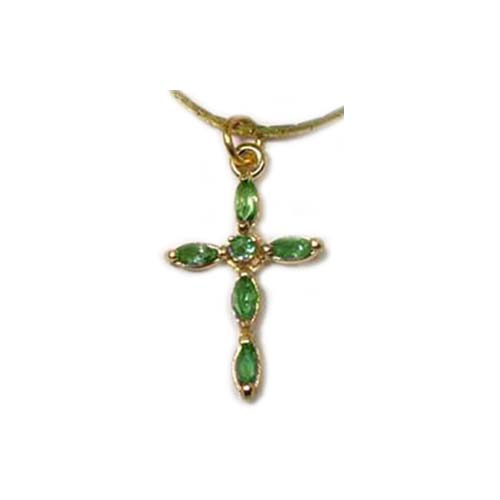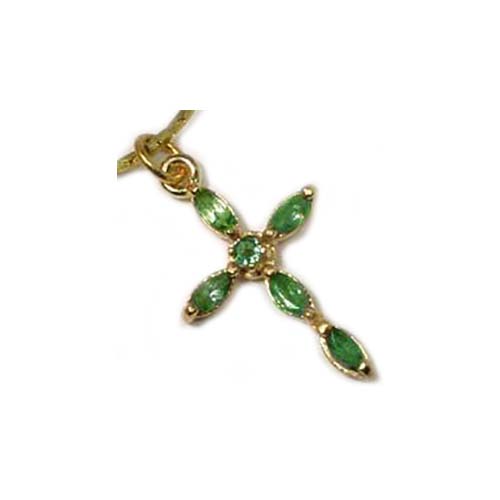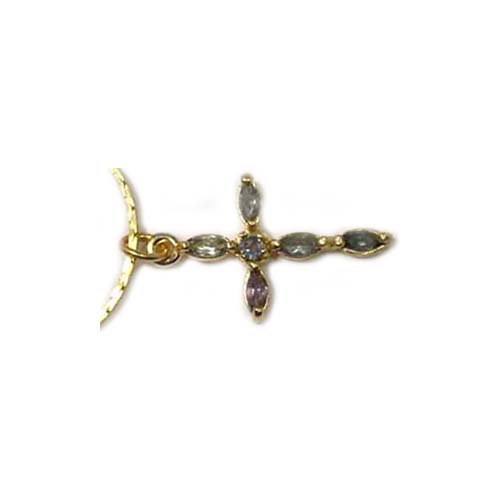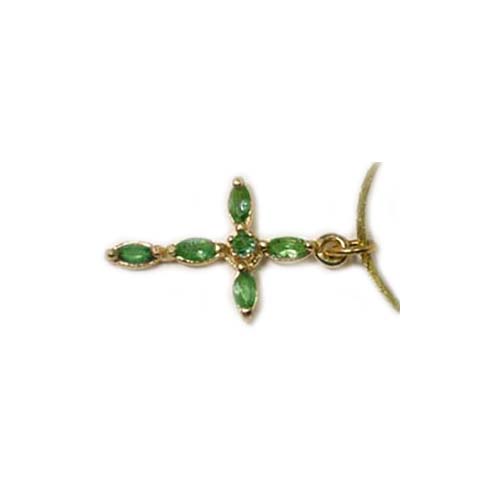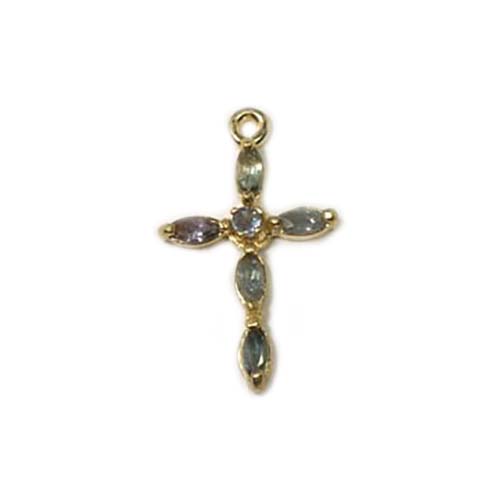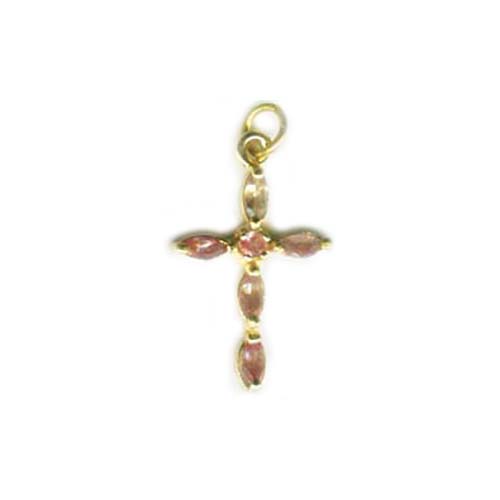Natural Russian Alexandrite Gemstones in 14kt Gold Cross Pendant $3299.99
Six Nineteenth Century Antique Handcrafted Genuine Natural Russian Color Change Alexandrite Precious Gemstones.Mounted into Contemporary High Quality 14kt Solid Gold Pendant.
CLASSIFICATION: Faceted Alexandrite Gemstones.
ORIGIN: Siberia, Russia, 19th Century. Chain and pendant setting contemporary.
SIZE:
MARQUISE: Length: 4mm. Breadth: 2mm. Depth: 1 1/2mm.
ROUND: Diameter: 2mm. Thickness (Depth): 1 1/4mm.
PENDANT: 25mm (length) 13mm (breadth).
WEIGHT: Approximately 0.55 carats (total gemstone weight).
NOTES: You may request a complimentary gold electroplate chain. We also have available chains in 14kt solid gold.
$3299.99
Details
Beware! The vast majority of alexandrite offered in the USA is synthetic. The American Gemological Institute estimates that less than 1 in every 100,000 Americans has ever even seen genuine, natural alexandrite. Here is a set of six stunning, brilliant, gorgeous, rare, natural green alexandrite gemstones from the Ural Mountains of Russia. The gemstones were hand crafted and faceted by a 19th century Russian artisan, part of an heritage renown for the production of the elaborate gemstones and jewelry of the Czars of Medieval, Renaissance, and Victorian Russia. Though we're not trying to intimate that the gemstones are absolutely flawless, to the eye at least the gemstones are clean and without discernible blemish; and yes, they are green; when they are so inclined, at least.
The color under most lighting conditions is the classic alexandrite green, reminiscent of both peridot and emerald. However under strong white light, the stones magically transforms themselves to a rose color with peach undertones. No matter what light source we used to image these gemstones, whether scanner or camera, they turned color. In hand, under most lighting conditions, they are most assuredly green.
But the charm of these remarkable gemstones, at least in the higher qualities, is the dramatic color change they are capable of. And true to its reputation, the light of the scanner turned these two gemstones rose-peach. And a decent digital camera shows them as blue-violet. The stones are capable of all of those colors, true chameleons, quite extraordinary precious gemstones. The green images shown here were produced using a filter so as to suppress the color changing characteristics of the gemstones and produce an image of matching color (to show you the normal color of the gemstones). But the remaining rose-peach and blue-violet images give more detail and show you what they look like “fully illuminated”. We matched them as best one can with a set of antique gemstones. In these photo enlargements here they might not appear perfectly matched, antique gemstones are in a sense like snowflakes, no two are exactly identical, at least under magnification. But as is the case with snowflakes, in hand, to the unaided eye, these gemstones are very well matched, almost indistinguishable from each other.
They are gorgeous gemstones, full of fire and sparkle, gorgeous, vibrant, possessing exceptional clarity and color. They are truly special little gemstones, quite rare. The gemstones were hand cut into these five faceted marquise (and one faceted round). . The setting is of contemporary origin. It is a high quality setting manufactured by one of the USA’s leading semi-custom mount producers. It is constructed of 14kt solid gold (not merely cheap gold electroplate or 5% gold fill). It is not a cheap, gold electroplated pendant setting. It is genuine 14kt solid gold, a quality setting designed to last a lifetime. The default chain is gold electroplated 24 inch (you may also choose a 16, 18, or 20 inch chain if you prefer). However we do have 14kt gold fill and 14kt solid gold chains available in lengths between 16 and 24 inches available upon request. The same setting is available in sterling silver at reduced cost.
For those who do not know, alexandrite was only produced for about fifteen years during Czarist (Imperial Russia), in the nineteenth century, before the only known mine of any significance played out. For over a hundred years the sole source of alexandrite was "recycled" Russian jewelry. Russian alexandrite is still considered to be the world's best, though very small deposits of inferior alexandrite have been found outside of the Urals in Russia in recent years. Given the rarity of the gemstone, and the enormous demand, reasonably good specimens are hard to find. Flawless specimens of any significant size have almost resulted in duels between buyers vying for the privilege of being a selected purchaser.
As might be expected under magnification the gemstones show the unmistakable, hallmark characteristics of having been hand crafted. The coarseness of the 19th century finish is considered appealing to most gemstone aficionados, and is not considered a detriment, or detract from the value of such gemstones. These characteristics are not only expected of hand-finished gemstones, many believe that such antique hand-crafted gemstones possess much greater character and appeal than today's mass-produced, laser-cut gemstones. Unlike today’s computer controlled machine produced gemstones that approach flawlessness in a perfect finish, the cut and finish of handcrafted gemstones like these is the legacy of an artisan who lived two centuries ago.
Handcrafted though they may be these gemstones have great luster and sparkle, and are absolutely transparent, but they are not entirely flawless. True, the blemishes they possess are virtually invisible to the naked eye, and to use trade jargon the gemstones can be characterized as "eye clean". However magnified as they are in the accompanying photo enlargements you might be able to discern a minute blemish or two within the stones. Of course much the same may said about almost any natural gemstone. An absolutely flawless gemstone simply is not the rule in nature.
Most absolutely flawless gemstones will upon close examination be revealed to be synthetic. You might also notice under magnification occasional irregularities in the cut and finish. Naturally these characteristics are not only expected of hand-finished gemstones, you must also consider that two centuries ago the mining techniques prevalent did not allow the ultra deep mining operations which are so common today.
Keep in mind that two centuries ago mankind was more or less limited to surface deposits or near surface deposits of semi-precious gemstones. Higher quality gemstones which today are routinely mined from beneath hundreds of meters, even kilometers beneath the earth's surface, were simply inaccessible. It is precisely for these reasons antique gemstones must be appreciated as antiques first, gemstones second. The relatively superlative quality of contemporary gemstones routinely mined from deep beneath the earth's surface today were simply not accessible two centuries ago, or at least, only rarely so. However for most, the unique nature and character of these antique gemstones more than makes up for the blemishes found within the gemstones, as well as the cutting irregularities common to handcrafted gemstones, all of which are by and large (if at all) are only visible under magnification.
ALEXANDRITE HISTORY: Alexandrite is known as a "color change" gemstone. It is emerald green in daylight or under fluorescent lighting, and a purplish red or blue under incandescent lighting, candlelight, or twilight. It belongs to the chrysoberyl family of gems, and one of the most extraordinary types is a cats-eye variety of alexandrite, possessing a remarkably prominent "cat's eye". Most sources credit the discovery of this very unique gemstone to the year 1830 on the birthday of Prince (and ultimately Czar) Alexander II in the Ural Mountains of Russia, near the city of Ekaterinburg. In celebration of Prince Alexander's coming-of-age, this remarkable gemstone was named after him. Alexandrite was popular in Imperial Russia both with the royal family and the wealthy elite, both because of its association with the Czar, and because red and green were the colors of the Russian Empire (and its flag).
However this most rare stone did not bring to Alexander the good fortune it is now generally associated with. Upon ascending to the throne of Russia, Alexander II began long-awaited reforms, including abolishing serfdom, a deed that earned him the name of “The Liberator”. But a terrorist’s bomb ended his life. In memoriam of the monarch who passed away so prematurely, many people in Russia started to wear alexandrite jewelry. It was considered to be the symbol of loyalty to the throne and compassion towards the victims of the revolutionary terror, but at the same time, it said a lot about the owner’s fortune and social position. Even in those times, it was quite difficult to buy an alexandrite ring. According to Leskov, “there were people who made quite an effort to find an alexandrite, and more often, they failed than succeeded.”
